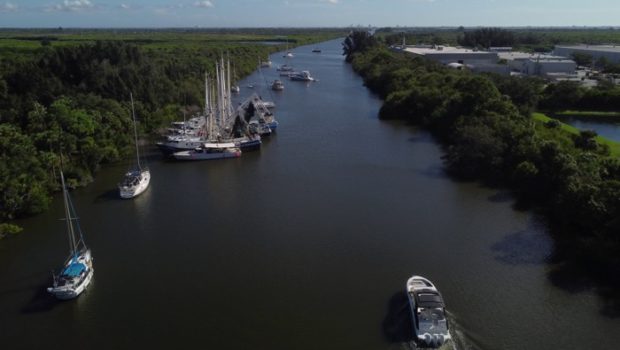Sheltering from Nicole in the Mangroves
Published on November 15th, 2022
Sailing Photojournalist Jan Pehrson was caught unexpectedly on the 36 foot sailboat “Slowpoke” directly in the path of Hurricane Nicole, a rare November hurricane that made landfall on the Florida East Coast with 70-75 mph winds. This is her first hand account.
November 7
Captain Ken and I have to move “Slowpoke” immediately from Canaveral Port due to approaching tropical storm Nicole. “Slowpoke” is tied to the dock like a spider web, after riding out the last hurricane, Hurricane Ian, in the slip.
She is secured like Gulliver in “Gulliver’s Travels” by Jonathan Swift. In the novel, the little people tied Gulliver up with a myriad of lines and captured him. Unlike Gulliver, “Slowpoke” is tied up for her own safety, but we must obey evacuation orders and leave in the morning.
We will go to the safest nearby place, that’s to tie up in the Canaveral Barge Canal to the mangrove bushes. Wish us luck. The port authority has given evacuation orders for the entire Canaveral Port, including all the large cruise ships and hundreds of small boats like ours. The mangroves are going to be crowded.
The winds aren’t expected to be that strong, maybe 40 knots gusting to 55, so I’m not sure why the port authority has given this order, but we must obey and get out. We should be OK as we have plenty of diesel and gas and water and we can make our own electricity and have a lot of food so we’ll be fine.
November 8
This morning “Slowpoke” was towed 4 miles up into the mangroves of the Barge Canal when Cape Marina at Port Canaveral was evacuated. Storm Nicole (I think now called Hurricane Nicole) is moving towards us on the Florida East Coast.
We learned that one reason for the evacuation is that a big storm surge is feared, and the Port Authority does not want the boats’ dock lines floating up over the pilings and the boats floating around free.
Now “Slowpoke’s” bow is into the mangroves, pointing towards the Northeast where the strongest winds are forecast for Wednesday and Thursday. We have two lines out on the port side, tied to palm trees. We have two lines out on the starboard side, tied to many feet of anchor chain and big anchors. We are waiting for Nicole.
Considering the circumstances, we think we are as prepared as possible.
We transited a lock coming here from Cape Canaveral. This lock will protect us from the storm surge that they are worried about and will cause flooding on the coast.
Fingers crossed.
After finishing their day’s work out on the Atlantic, the commercial shrimpers arrive in our hurricane hole, lighting up the sky. Like us cruisers, they nose into the mangroves, wade ashore, and tie up to palm trees. These folks who work on the ocean for a living are here, like us, to hide from Storm Nicole, now causing a swell of 20 to 25 feet out on the Atlantic Ocean. They can’t fish. The worst is expected to come tonight, they are now forecasting 60-70 as the storm changes its trajectory.
November 10
Very challenging night on “Slowpoke” but Captain Ken and I made it through Hurricane Nicole safely.
I’ve sailed on boats of this size through hurricane force winds twice before, with winds exceeding 70 mph on our stern. Both times, the winds weren’t organized into rotating storms known as cyclones so technically weren’t “hurricanes.”
Hurricane Nicole made landfall about 50 miles south of here with sustained 70 mile an hour winds, gusting higher. Nearby, at NASA’s moon rocket on Kennedy Space Center launch pad, Nicole whipped a 100-mph gust.
As the eye passed at four AM, our winds changed direction, and clocked from north to east to south.
“Slowpoke,” and many of the boats anchored and tied to palm trees around here, ended up pushed by the southerly winds up against the mud banks of the mangroves, aground. We sailboats are parallel to the shore on the north side of the barge canal that extends east to west. All of us will pull out of the mangroves when the wind finally dies down and the marinas re-open after inspection. We are OK, “Slowpoke” is unscathed, and it’s time to rest up now.
During Nicole, water was flying, driven in sheets across the sky by the wind, wind so strong we had to hang on tight and couldn’t move about the deck. We wore our life jackets, dressed in long pants and gloves in case we ended up on land, put our valuables in dry bags, and tethered on. We waited throughout the night for the violent gusts to end, and the unknown to become known. We thought about trying to adjust some of our lines, but the forces were too great to do this safely.
We were not in peril, so rather than act on impulse we watched and waited. Less is often more.
Some boats were damaged by the storm. All night long the coast guard responded to distress calls — this is the first time I’ve personally heard a “Mayday” over the radio.
Slowpoke is a Morgan Out Island 36, so fortunately came through unscathed after this experience of being up-close-and-personal with the mangroves.
Designed for coastal cruising with a modified full keel, her big-fat-bottom hull shape is ideal for this service. It protects her rudder & propeller and entire underbody from damage if she runs up on a sandbar, or in this case on mud.

During Nicole, some sailboats washed ashore or were blown onto bridges. See sunken sailboat photo, with deployed life raft at lower right and bridge behind.
November 11
Good morning from “Slowpoke” following Hurricane Nicole! Slowpoke is floating gracefully now, alongside the mangrove-lined shores of Canaveral Barge Canal.
A combination of high tide & not being driven onshore by 70 mph winds did the trick and floated us. We rose from the mud. Zero damage, no lines parted, no anchors lost. Just muddy. We gave a big SIGH of relief. Due to the shape of her fat bottom, “Slowpoke” didn’t really mind sitting in the mud, but it’s better to be floating — that’s what boats do best after all.
The chart plotte r shows our track during the storm. Yellow is mangroves. White is water. We are now in the white (water) part and so floating! Yay!
r shows our track during the storm. Yellow is mangroves. White is water. We are now in the white (water) part and so floating! Yay!
Mangroves make rookeries for fish and aviaries for birds. They create new islands. Now I know, from personal experience, they also shelter boats in their lee during storms. We are grateful. And if things get really tough, some mangrove leaves are edible if prepared properly. They taste like salted celery we hear!
Jan Pehrson is a sailing photojournalist who spends summers in San Francisco, California and winters in St. Pete Beach, Florida. As a racing and cruising sailor and Coast Guard licensed skipper, Jan’s familiarity with sailing and the sailing community lends an in-depth element to her prolific array of photographs and articles. Contact her at www.janpehrson.com









 We’ll keep your information safe.
We’ll keep your information safe.